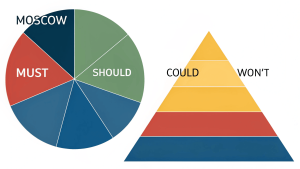Choosing the right project management methodology can make or break your project’s success. Are you torn between Agile and Waterfall? Each has its strengths and challenges, but which one fits your unique project needs? In this article, we’ll explore both methods, helping you decide the best approach to deliver results efficiently and effectively.
Effective task prioritization is a fundamental skill that directly impacts the success of any project. Without it, even the most talented teams can struggle to meet deadlines, stay within budget, or achieve quality standards. Prioritization ensures that the project focus remains on activities that generate the highest value and mitigate critical risks. It’s about directing limited resources—time, budget, and manpower—toward what truly matters, preventing wasted effort and costly delays.
Common Challenges in Task Prioritization
Project managers often face several obstacles when attempting to prioritize tasks:

- Lack of clarity on objectives: Without clear goals, it’s difficult to determine which tasks are essential.
- Conflicting stakeholder demands: Different interests can lead to competing priorities.
- Overwhelming volume of tasks: Large projects generate complex task lists that require careful organization.
- Dynamic project environments: Changes in scope, resources, or market conditions force constant reprioritization.
Why Do All Tasks Seem Urgent?
When faced with multiple deadlines and urgent requests, the natural reaction is to treat everything as a priority. However, this approach leads to inefficiency and burnout. The key is to distinguish between urgent and important tasks, aligning them with strategic objectives.

Managing Stakeholder Conflicts
Stakeholders often have differing views on what should be prioritized, based on their own interests. Effective communication and negotiation skills are essential for balancing these perspectives and achieving consensus.
Proven Methods for Prioritizing Tasks
Several established frameworks can help managers objectively prioritize tasks and enhance project outcomes.
The Eisenhower Matrix
This method categorizes tasks into four quadrants based on urgency and importance, guiding decision-making:
| Urgent & Important | Important but Not Urgent |
|---|---|
| Execute immediately | Schedule appropriately |
| Urgent but Not Important | Neither Urgent nor Important |
| Delegate or minimize | Eliminate or postpone |
MoSCoW Prioritization

This approach breaks tasks down into:
- Must have: Essential tasks without which the project fails.
- Should have: Important but not critical.
- Could have: Nice to have if resources permit.
- Won’t have: Excluded from the current scope.
ABC Analysis
Tasks are assigned categories reflecting their impact:
- A: High-impact, high-priority.
- B: Moderate importance.
- C: Low priority or optional.
Practical Tips to Enhance Task Prioritization
- Align tasks with project goals: Confirm that every task supports overall objectives.
- Break down complex tasks: Smaller tasks are easier to evaluate and schedule effectively.
- Maintain open communication: Engage your team and stakeholders in priority setting to foster alignment.
- Utilize project management software: Tools like Asana, Jira, or Microsoft Project can visualize and adjust priorities dynamically.
- Regularly review and adjust: Priorities should be revisited frequently to adapt to changes.

Adapting to Changing Priorities
Project landscapes are rarely static. New challenges or opportunities require flexibility. To adapt effectively:
- Assess impact before adjusting: Consider consequences on timelines and resources.
- Communicate changes promptly: Keep all team members and stakeholders informed.
- Maintain contingency buffers: Build time allowances to accommodate shifts.
Case Study: Prioritization in a Software Development Project
Consider a software launch with tasks including coding, testing, documentation, and marketing. Using the Eisenhower Matrix, urgent bugs identified during testing take precedence, while marketing plans are important but can be scheduled after critical fixes. Minor UI enhancements may be delegated or deferred. This structured prioritization helps the team focus on what ensures a successful launch without burnout or confusion.
Common Pitfalls and How to Avoid Them
- Ignoring input from key team members: Excludes valuable insights.
- Over-prioritizing “urgent” tasks: Leads to exhaustion and neglect of strategic activities.
- Failing to update priorities: Creates misalignment with project progress.
- Neglecting task dependencies: Results in bottlenecks or rework.

Benefits of Effective Task Prioritization
When done well, task prioritization improves:
- Team focus and motivation.
- Efficient use of time and resources.
- Ability to meet deadlines and budget goals.
- Clear communication and accountability.
“Effective prioritization turns a list of tasks into a strategic roadmap, driving projects to successful completion.”
Understanding the differences between Agile and Waterfall empowers you to select the method that aligns with your project goals, team dynamics, and client expectations. Whether you prefer flexibility or a structured approach, choosing wisely leads to smoother workflows and better outcomes. Ready to pick the right methodology and boost your project’s success? Dive deeper into Agile and Waterfall strategies today!
